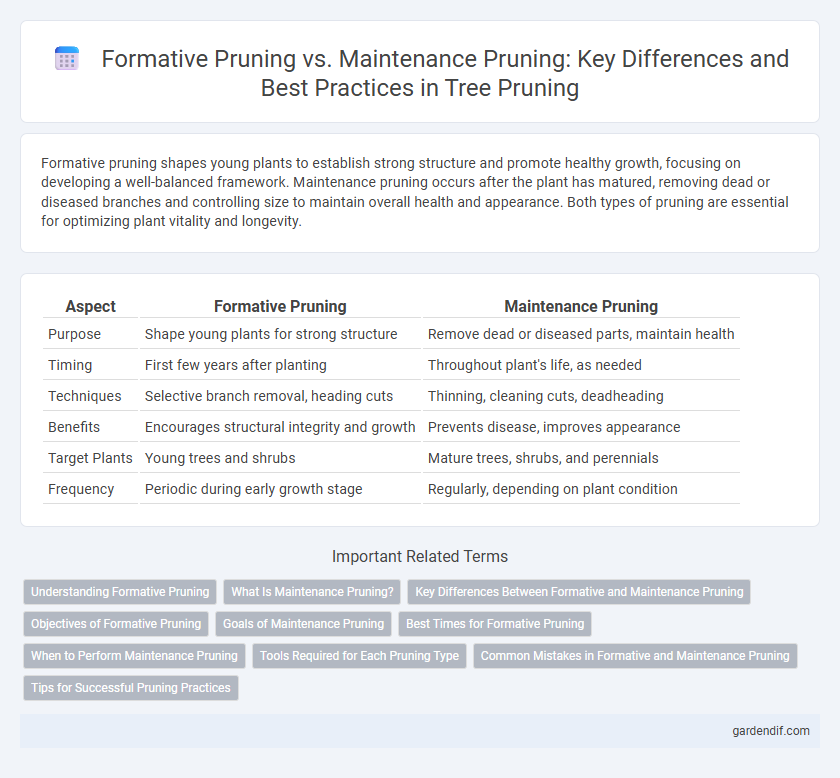
formative pruning vs maintenance pruning Illustration
Formative pruning shapes young plants to establish strong structure and promote healthy growth, focusing on developing a well-balanced framework. Maintenance pruning occurs after the plant has matured, removing dead or diseased branches and controlling size to maintain overall health and appearance. Both types of pruning are essential for optimizing plant vitality and longevity.
Table of Comparison
| Aspect | Formative Pruning | Maintenance Pruning |
|---|---|---|
| Purpose | Shape young plants for strong structure | Remove dead or diseased parts, maintain health |
| Timing | First few years after planting | Throughout plant's life, as needed |
| Techniques | Selective branch removal, heading cuts | Thinning, cleaning cuts, deadheading |
| Benefits | Encourages structural integrity and growth | Prevents disease, improves appearance |
| Target Plants | Young trees and shrubs | Mature trees, shrubs, and perennials |
| Frequency | Periodic during early growth stage | Regularly, depending on plant condition |
Understanding Formative Pruning
Formative pruning shapes young trees to establish a strong structure that supports future growth and fruit production, preventing structural problems. It involves selective removal of branches to encourage proper branch angles and balanced canopy development, which enhances light penetration and air circulation. This proactive approach contrasts with maintenance pruning, which focuses on correcting issues and preserving tree health in mature plants.
What Is Maintenance Pruning?
Maintenance pruning involves selectively removing dead, diseased, or overgrown branches to promote the health and aesthetics of mature trees and shrubs. This type of pruning helps maintain structural integrity, prevents hazards, and encourages balanced growth by managing canopy density and airflow. Unlike formative pruning, which shapes young plants, maintenance pruning is a routine practice essential for long-term plant vitality.
Key Differences Between Formative and Maintenance Pruning
Formative pruning primarily shapes young plants to establish strong structure and optimal growth patterns, while maintenance pruning focuses on preserving plant health, removing dead or diseased wood, and managing size in mature plants. Formative pruning involves selective cuts during early growth stages to encourage desirable branch architecture, whereas maintenance pruning occurs regularly to sustain plant vigor and aesthetic appearance. Understanding these key differences ensures effective pruning strategies that maximize plant longevity and productivity.
Objectives of Formative Pruning
Formative pruning aims to establish a strong tree structure by shaping young trees, removing weak or crossing branches, and promoting proper scaffold development. This process enhances tree health, improves light penetration, and supports long-term growth and fruit production. Prioritizing formative pruning ensures structural integrity and reduces the need for extensive corrective pruning in later stages.
Goals of Maintenance Pruning
Maintenance pruning aims to preserve the health, safety, and aesthetics of mature trees by removing dead, diseased, or hazardous branches that could pose risks to property or people. It enhances tree structure and longevity by improving air circulation and preventing decay, reducing the likelihood of pest infestations or storm damage. Regular maintenance pruning supports optimal growth patterns and maintains the desired shape without stimulating excessive new shoots.
Best Times for Formative Pruning
Formative pruning is most effective during the early stages of a plant's growth, typically in late winter to early spring before new growth begins. This timing helps establish strong branch structure and prevents future structural problems by selectively removing weak or crossing branches. Maintenance pruning, by contrast, is generally performed throughout the growing season to remove dead or diseased wood and maintain plant health.
When to Perform Maintenance Pruning
Maintenance pruning should be performed during the late winter or early spring before new growth begins, ensuring the removal of dead or diseased branches to promote healthy development. It is critical to prune after the initial formative pruning phase, focusing on sustaining tree structure and preventing overcrowding. Timely maintenance pruning enhances air circulation and sunlight penetration, reducing the risk of pest infestations and improving overall plant vigor.
Tools Required for Each Pruning Type
Formative pruning requires precision tools such as hand pruners, loppers, and sometimes a pruning saw to shape young trees and establish strong branch structure. Maintenance pruning often utilizes similar tools but may also involve pole pruners and pruning shears to manage mature tree growth and remove dead or diseased branches. Proper use of sharp, clean tools is essential in both pruning types to promote healthy plant development and prevent disease transmission.
Common Mistakes in Formative and Maintenance Pruning
Common mistakes in formative pruning include removing too much foliage early, which can stress young plants and inhibit proper structure development. In maintenance pruning, frequent over-pruning or failing to remove dead or diseased branches can weaken the tree and increase susceptibility to pests. Both pruning types benefit from timely cuts made with sharp tools to promote healthy growth and prevent damage.
Tips for Successful Pruning Practices
Formative pruning shapes young plants by removing weak or crossing branches to establish a strong framework, enhancing overall structure and future growth potential. Maintenance pruning involves regularly cutting back overgrown or dead branches to improve plant health, air circulation, and light penetration. Consistent monitoring, using sharp and clean tools, and pruning during appropriate seasons are essential tips to promote optimal plant vitality and longevity.
formative pruning vs maintenance pruning Infographic

 gardendif.com
gardendif.com